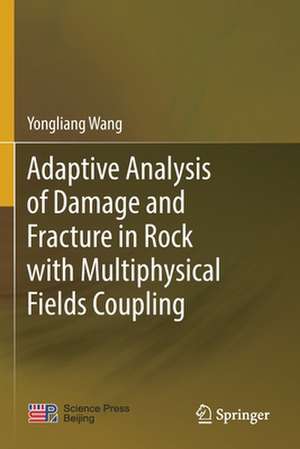Adaptive Analysis of Damage and Fracture in Rock with Multiphysical Fields Coupling
Autor Yongliang Wangen Limba Engleză Paperback – 31 aug 2021
This book proposes adaptive numerical algorithms and simulation analysis methods that offer significant advantages in terms of accuracy and reliability. It helps readers understand these innovative methods quickly and easily. The content consists of: (1) a finite element algorithm for modeling the continuum damage evolution in rocks, (2) adaptive finite element analysis for continuum damage evolution and determining the wellbore stability of transversely isotropic rock, (3) an adaptive finite element algorithm for damage detection in non-uniform Euler–Bernoulli beams with multiple cracks, using natural frequencies, (4) adaptive finite element–discrete element analysis for determining multistage hydrofracturing in naturally fractured reservoirs, (5) adaptive finite element–discrete element analysis for multistage supercritical CO2 fracturing and microseismic modeling, and (6) an adaptive finite element–discrete element–finite volume algorithm for 3D multiscale propagation of hydraulic fracture networks, taking into account hydro-mechanical coupling. Given its scope, the book offers a valuable reference guide for researchers, postgraduates and undergraduates majoring in engineering mechanics, mining engineering, geotechnical engineering, and geological engineering.
| Toate formatele și edițiile | Preț | Express |
|---|---|---|
| Paperback (1) | 777.03 lei 6-8 săpt. | |
| Springer Nature Singapore – 31 aug 2021 | 777.03 lei 6-8 săpt. | |
| Hardback (1) | 783.05 lei 6-8 săpt. | |
| Springer Nature Singapore – 31 aug 2020 | 783.05 lei 6-8 săpt. |
Preț: 777.03 lei
Preț vechi: 947.59 lei
-18% Nou
Puncte Express: 1166
Preț estimativ în valută:
148.70€ • 155.05$ • 123.59£
148.70€ • 155.05$ • 123.59£
Carte tipărită la comandă
Livrare economică 21 martie-04 aprilie
Preluare comenzi: 021 569.72.76
Specificații
ISBN-13: 9789811571992
ISBN-10: 9811571996
Ilustrații: XI, 196 p. 117 illus., 88 illus. in color.
Dimensiuni: 155 x 235 mm
Greutate: 0.3 kg
Ediția:1st ed. 2021
Editura: Springer Nature Singapore
Colecția Springer
Locul publicării:Singapore, Singapore
ISBN-10: 9811571996
Ilustrații: XI, 196 p. 117 illus., 88 illus. in color.
Dimensiuni: 155 x 235 mm
Greutate: 0.3 kg
Ediția:1st ed. 2021
Editura: Springer Nature Singapore
Colecția Springer
Locul publicării:Singapore, Singapore
Cuprins
Introduction.- Finite element algorithm for continuum damage evolution of rock considering hydro-mechanical coupling.- Finite element analysis for continuum damage evolution and wellbore stability of transversely isotropic rock considering hydro-mechanical coupling.- Finite element analysis for continuum damage evolution and inclined wellbore stability of transversely isotropic rock considering hydro-mechanical-chemical coupling.
Notă biografică
Dr. Yongliang Wang, Associate Professor, works at the School of Mechanics and Civil Engineering, China University of Mining and Technology, Beijing. He is a board member of the Soft Rock Branch of the Chinese Society for Rock Mechanics and Engineering, and a member of the Chinese Society of Theoretical and Applied Mechanics, China Civil Engineering Society, and China Coal Society. His research interests include computational mechanics, mining engineering, geotechnical engineering and geological engineering.
Textul de pe ultima copertă
This book mainly focuses on the adaptive analysis of damage and fracture in rock, taking into account multiphysical fields coupling (thermal, hydro, mechanical, and chemical fields). This type of coupling is a crucial aspect in practical engineering for e.g. coal mining, oil and gas exploration, and civil engineering. However, understanding the influencing mechanisms and preventing the disasters resulting from damage and fracture evolution in rocks require high-precision and reliable solutions.
This book proposes adaptive numerical algorithms and simulation analysis methods that offer significant advantages in terms of accuracy and reliability. It helps readers understand these innovative methods quickly and easily. The content consists of: (1) a finite element algorithm for modeling the continuum damage evolution in rocks, (2) adaptive finite element analysis for continuum damage evolution and determining the wellbore stability of transversely isotropic rock, (3) an adaptive finite element algorithm for damage detection in non-uniform Euler–Bernoulli beams with multiple cracks, using natural frequencies, (4) adaptive finite element–discrete element analysis for determining multistage hydrofracturing in naturally fractured reservoirs, (5) adaptive finite element–discrete element analysis for multistage supercritical CO2 fracturing and microseismic modeling, and (6) an adaptive finite element–discrete element–finite volume algorithm for 3D multiscale propagation of hydraulic fracture networks, taking into account hydro-mechanical coupling. Given its scope, the book offers a valuable reference guide for researchers, postgraduates and undergraduates majoring in engineering mechanics, mining engineering, geotechnical engineering, and geological engineering.
This book proposes adaptive numerical algorithms and simulation analysis methods that offer significant advantages in terms of accuracy and reliability. It helps readers understand these innovative methods quickly and easily. The content consists of: (1) a finite element algorithm for modeling the continuum damage evolution in rocks, (2) adaptive finite element analysis for continuum damage evolution and determining the wellbore stability of transversely isotropic rock, (3) an adaptive finite element algorithm for damage detection in non-uniform Euler–Bernoulli beams with multiple cracks, using natural frequencies, (4) adaptive finite element–discrete element analysis for determining multistage hydrofracturing in naturally fractured reservoirs, (5) adaptive finite element–discrete element analysis for multistage supercritical CO2 fracturing and microseismic modeling, and (6) an adaptive finite element–discrete element–finite volume algorithm for 3D multiscale propagation of hydraulic fracture networks, taking into account hydro-mechanical coupling. Given its scope, the book offers a valuable reference guide for researchers, postgraduates and undergraduates majoring in engineering mechanics, mining engineering, geotechnical engineering, and geological engineering.
Caracteristici
Presents reliable computational analysis methods for multiphysical fields coupling in deep geological rocks
Offers accurate and high-performance adaptive algorithms for damage and fracture in rock mass
Addresses the practical and adaptive analysis of continuous damage evolution in anisotropic rocks
Offers accurate and high-performance adaptive algorithms for damage and fracture in rock mass
Addresses the practical and adaptive analysis of continuous damage evolution in anisotropic rocks
